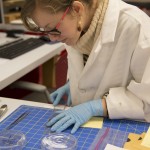Housing the Public Library’s historic stained glass
According to the CHPL website, when the original Main Library at 629 Vine Street opened to the public in 1873, three beautiful and intricate stained glass windows graced one of the reading rooms in the building. In 1955, when the building was demolished, the windows were sold at auction, later to resurface as part of the decor of the Old Spaghetti Factory on Pete Rose Way. After the restaurant closed to make room for Paul Brown Stadium, the Library purchased the windows and began making plans to return them to the Main Library for the appreciation and enjoyment of our customers and staff. Thanks to the generosity of the Friends and the Annabel Fey Trust Fund, the three windows have now been re-created and restored to their original glory and are on permanent display in the Main Library.
…


